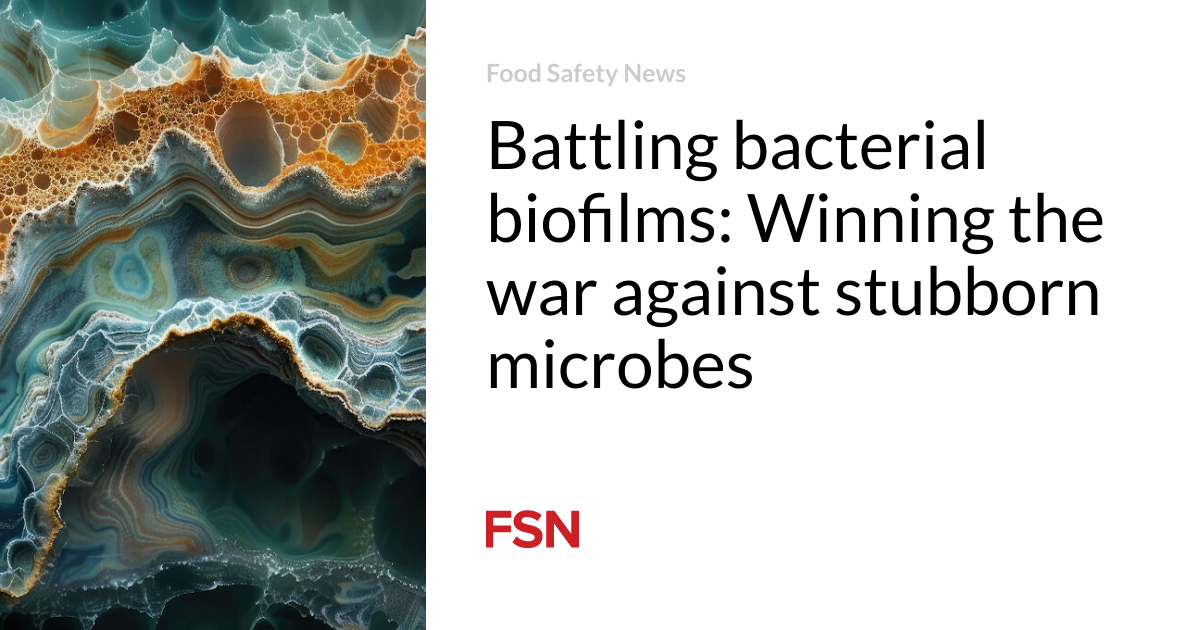Food
Fighting bacterial biofilms: winning the war against persistent microbes

By Michael Arthur
Imagine a group of bacteria working together as a gang and creating a fortress around them. This is essentially what bacterial biofilms are: a tough, sticky barrier that makes them incredibly difficult to defeat. They form on medical devices, water pipes, kitchen surfaces and even in our bodies, leading to persistent infections and contamination. In the food industry, bacterial biofilms formed on food and non-food contact surfaces are associated with many foodborne outbreaks.
Once attached to surfaces, biofilms can remain for long periods of time, ranging from days to years. A recent scientific study found that Listeria monocytogenes biofilms persisted on contact surfaces in a seafood processing environment for 17 years (see below for more information). Although this formidable microbial community is resistant to chemical, physical or biological treatments, there are proven ways to deal with it.
How can we combat these persistent communities?
Chemicals, such as chlorine, hydrogen peroxide and peracetic acid, are often used to combat bacterial biofilms. These agents contain powerful active ingredients that can penetrate the biofilm community and attack the membranes of each cell to cause damage, which can ultimately result in cell death. Although these chemicals can effectively destroy bacterial biofilms, their application needs to be optimized.
First, the chemical should be applied according to the manufacturer’s recommendations for concentration and contact time. This is very important because these smart biofilms, when applied below the amount recommended by the manufacturer, will build up resistance to the agents, making them ineffective. In our laboratory experiments, we found that when chemicals were applied without following manufacturer’s recommendations, biofilms were not completely destroyed.
Second, it is recommended to use topical chemicals instead of those that have expired. The expired chemicals have fewer active ingredients; therefore, they will not completely eradicate the bacterial biofilm. What is concerning is that when we use outdated products for a long period of time, bacterial biofilms will be able to develop special mechanisms to resist the chemical agents when outdated products are used later. This is when we say that bacteria have become resistant to certain chemicals.
Finally, it is essential to rotate the chemical agents. For example, if a hydrogen peroxide agent is used for about one or two months, it can be changed to a chlorine-based agent and vice versa. This reduces the resistance mechanisms of the bacterial biofilms.
Conclusion
Fighting bacterial biofilms is like fighting a well-fortified enemy or playing a game of strategic chess. It takes a combination of tactics. As research continues, we are getting better at outsmarting these resilient bacterial communities and keeping our environment safer and cleaner.
About the author: Michael Arthur is a Ph.D. student at Technological University Dublin (TUD), but based at Ashtown Teagasc Food Research Centre, in the Food Safety Department. His Ph.D. project focuses on “evaluating the microbial quality of harvested rainwater and sustainable treatment options for the horticultural sector”. He is guided by Dr. Kaye Burgess (Teagasc), Prof. Jesus Frias (ESHI – TUD) and Dr. Michael T. Gaffney (Teagasc). This project was funded by the Department of Agriculture, Food and the Marine (project 2019R424) and the Teagasc Walsh Scholarship Program (Ref. 2021055).
Read further
Daeschel, D., Pettengill, J.B., Wang, Y., Chen, Y., Allard, M., Snyder, A.B., 2022. Genomic analysis of Listeria monocytogenes from US food processing environments show high prevalence of QAC efflux genes, but limited evidence of their contribution to environmental persistence. BMC Genomics 23, 488. https://doi.org/10.1186/s12864-022-08695-2











